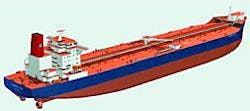Market Movement
AGA-EIA storage data transition a concern
The transition of weekly gas storage reporting duties to the US Department of Energy's Energy Information Administration from the American Gas Association last week had many industry participants and observers questioning the possible impact on the market's ability to assess supply and demand fundamentals this summer.
"Initially, there may be some confusion based upon the fact that the total DOE storage numbers should be about 125 bcf higher than the last AGA numbers," said J. Marshall Adkins, managing director of energy re- search and senior oil field service equity analyst for Raymond James & Associates Inc. (RJA), St. Petersburg, Fla.
Nonetheless, he said, "Once we get past [the first] week, we believe the transition to new gas storage reports will be nearly seamless and should not materially contribute to gas price volatility this summer."
Late last week, EIA officials reported US gas storage increased to 1.59 tcf for the week ended May 3, up from 1.55 tcf the previous week (see table). "That seems to match our prediction of an additional 125 bcf, although we can get a better reading after a few weeks [with additional reports]," another RJA official told OGJ.
The sampling methodology and reporting format EIA uses in its weekly gas storage reports apparently is similar to that of AGA. EIA plans to survey 45 companies, vs. AGA's average sample of 42-43. Respondents are encouraged to submit revisions to the prior week's data with changes greater than 1 bcf, with explanations of any unusual activity that may have contributed to that revision.
Different totals
Both DOE and AGA typically have been very close in the volumes of working gas in storage that they report at the start of the official US heating season Nov. 1. "However, at the beginning of the refill season [Apr. 1], the DOE's reported volumes of working gas in storage were approximately 135 bcf above those reported by the AGA," Adkins said. "Additionally, the DOE's total reported injections and withdrawals average approximately 65 bcf [or 2 bcf/week] less per season than the AGA's total reported injections and withdrawals."
Consequently, about half the difference of the apparent 125 bcf jump in storage figures "will likely be made up over the summer, since the DOE historically measures about 2 bcf/week smaller injections than the AGA," said Adkins.
"Therefore, our summer-ending forecast of 2,900-3,000 bcf of gas in storage remains intact, and any short-term negative reaction to the discreet jump in inventories should be short-lived.
Storage outlook
Meanwhile, Adkins said, "We believe a combination of rapidly declining US production, as well as a modest recovery in demand, will lead to summer injections that are 40% below 2001 levels on average."
Gas producers representing about half of total US gas supply have reported their first quarter production this year was down 2.5% from the fourth quarter of 2001 and by 4.5% on a year-over-year basis (OGJ, May 6, 2002, p. 7).
"While US gas production is not likely to fall another 2.5% in the second quarter of 2002," Adkins said, "we do believe that it is likely to continue falling sequentially by at least another 1.5% next quarter.
"That means that the year-over-year gas supply gap should continue to widen to over 6% [3 bcfd] as we move through the summer."
He said, "Because a supply problem is much harder to correct than a demand problem, we believe falling US supply will be the driver behind natural gas prices over the next 6-12 months."
Moreover, Adkins said, "With strong oil prices raising the switch point for residual fuel to nearly $4/MMbtu, as well as anecdotal evidence that the manufacturing sector is recovering, we can conservatively model a modest increase [2 bcfd] in demand for natural gas this summer."
The result, he said, is that gas storage injections should average 40% lower this year compared with last year.
"Consequently, we believe that volumes of working gas in storage will not reach 3,000 bcf by Nov. 1 and that the underlying supply problem facing the market could create another natural gas shock next winter," said Adkins.
Industry Scoreboard
null
null
null
Industry Trends
THE GULF OF MEXICO oil service sector is experiencing signs of an upturn, analysts with Simmons & Co. International, UBS Warburg LLC, and RBC Dain Rauscher Inc. noted in recent reports.
Simmons & Co., a Houston investment banking house, said, "It is reasonable to expect that the premium Gulf of Mexico jack up rigs [capable of drilling in water depths greater than 250 ft] are on the verge of meaningful day rate increases. This, in turn, should provide a catalyst to eventually pull up day rates of the lower-end GOM jack ups."
Kurt Hallead, an Austin analyst with RBC Dain Rauscher, said Gulf of Mexico rig utilization and day rates are rising on higher natural gas prices, improved drilling economics, and increased exploration and production spending.
"For 2002, we foresee [rates of] 350 ft jack ups rising by 9% to $36,000/day from $33,000/day; 300 ft, up by 12.5% to $27,000 from $24,000; and 250 ft, increasing by 16% to $22,000 from $19,000," Hallead said of Gulf of Mexico jack up day rates.
"For 2003, we foresee 350 ft jack ups rising by 15% to $45,000/day from $39,000/day; 300 ft, up by 23% to $38,000 from $31,000; and 250 ft, increasing by 8% to $27,000 from $25,000, Hallead said of a recently revised RBC Dain Rauscher forecast.
Jack up rig utilization bottomed in mid-December and has been steadily rising as a result of greater drilling activity and the migration of rigs out of the Gulf of Mexico to other markets, Simmons & Co. said (see table).
Total rig utilization has been flat year-to-date, with jack up activity increasing while floater activity decreased. Overall Gulf of Mexico rig utilization has been at 59-62% since late last year.
The overall jack up utilization "has masked the significant activity of the premium-end jack ups," Simmons said. Current utilization of the premium jack up fleet is 94%.
UBS Warburg analyst James Stone of New York said his firm's third edition of its monthly Patchwork Survey "indicates an upturn is around the corner. North American operators are finally responding to commodity price signals and preparing to increase spending and activity levels."
The survey compiles responses from oil and gas operating personnel, who are polled monthly as to their expectations of price and activity level (OGJ, Apr. 15, 2002, p. 7).
Survey respondents' budgets are based on an average oil price of $20.65/bbl and an average natural gas price of $2.70/Mcf.
"Only 4% of [US and Canadian] operators plan to reduce spending in the next 60 days, while 53% plan no change, and 43% plan an increase," Stone said.
"In [the US and Canada], drilling activity expectations are turning up for the first time, reversing last month's data; 48% of respondents planned to increase drilling, 8% planned to decrease, and 44% did not plan any changes," he said.
Government Developments
US DEPARTMENT OF STATE officials May 6 said there is a "strong consensus" among the permanent members of the United Nations Security Council to support a new system of export controls on Iraq as part of the oil-for-aid program.
The new "smart" sanctions plan, under discussion for over a year, would lift UN controls on humanitarian and civilian goods purchased with Iraq oil revenue. But in turn, Iraq would have to allow the UN to resume weapons inspections. As of presstime, a more formal UN proposal was expected.
"This change should further improve the flow of humanitarian and civilian goods to the Iraqi people," a US State department spokesman said. "Of course, it will work only if the Iraqi regime begins to cooperate fully with the oil-for-food program rather than working to undermine it, and particularly by using its oil as a propaganda tool."
Iraq resumed exports under the UN aid program on May 7 after a month's absence. It had withdrawn exports from the world oil markets to protest Israeli troops in Palestinian areas. Iraq had sought solidarity from other Arab oil exporters, but they refused to join the boycott.
UN officials estimate Iraq's action resulted in a $1.3 billion loss for the aid program, which the State department calls "the mainstay of the Iraqi civilian economy."
The UN oil-for-aid program began in 1996 to help ordinary Iraqis cope with sanctions imposed after Iraq's 1990 invasion of Kuwait. The program initially provided for the importation of food and basic humanitarian goods but has since been expanded to cover public services such as education and water supply.
REFINERS ARE DISAPPOINTED that a US Court of Appeals for the DC Circuit upheld the timing of a controversial low-sulfur diesel fuel standard issued by the Environmental Protection Agency.
Bob Slaughter, president of the National Petrochemical & Refiners Association said the NPRA has consistently supported environmental improvements such as low-sulfur fuels. But he said this case "has never been about whether the sulfur content of highway diesel fuel will be substantially reduced; it will be." Slaughter said the case concerned whether sulfur reductions should occur in a reasonable timeframe to maintain needed fuel supplies.
NPRA officials said they are studying the decision and have not yet made a decision on whether they will appeal the rule.
In an earlier written statement, NPRA said that if EPA is the final court of opinion on the impact the rules have on fuel supply, then Congress and President George W. Bush's administration "must insist that EPA pay more attention to the timing and sequencing of future rules than it did in this case."
NPRA also lauded the court for holding that EPA is legally required to assure an adequate fuel supply in rules of this kind.
Meanwhile, environmental groups praised the court action. Frank O'Donnell, executive director of Clean Air Trust, said it was a "huge victory" for clean air.
Quick Takes
SEAHORSE SHUTTLING & TECHNOLOGY LLC, a wholly owned unit of Conoco Inc., has completed the functional design of a new tanker for shuttling crude oil from the deepwater Gulf of Mexico to shore.
The design initiative was unveiled at the Offshore Technology Conference in Houston last week (See related article).
The first of the shuttle tankers could be operational in the Gulf of Mexico by 2005, Conoco said.
The new shuttle will have a capacity of 550,000 bbl of crude oil. With a 40-ft draft, it will be able to enter most ports on the US Gulf of Mexico, ushering in a new era for US deepwater production.
The new era began last December when the US Minerals Management Service approved in principle the use of shuttle tankers and floating production, storage, and offloading vessels for crude oil production and transportation in the central and western deepwater Gulf of Mexico (OGJ Online, Jan. 2, 2002). Use of such vessels will enable the production of crude oil from deepwater areas currently inaccessible by pipelines.
Oil production from the deepwater Gulf of Mexico is increasing rapidly-by 24% in 2001 from 2000, according to MMS Regional Director Chris Oynes. An estimated 570 million bbl of oil was produced in 2001 from all of the Gulf of Mexico, an increase from 522 million bbl in 2000.
"Interest from potential customers has increased dramatically since MMS issued its environmental impact study," said Matthew Prichard, vice-president of marketing and commercial development for Seahorse. "We believe US-built shuttle tankers will compete favorably with pipelines as oil and natural gas discoveries move into the deeper water depths in the Gulf of Mexico, where pipeline construction is costly and operations are more difficult."
The shuttle tanker design is the result of a shipbuilding alliance of Conoco, Alabama Shipyard of Mobile, Ala., and Samsung Shipbuilding & Heavy Industries of South Korea.
Designed by Samsung specifically for production at Alabama Shipyard, the new shuttle tankers would meet the Jones Act requirement that vessels operating totally in US waters be constructed in the US. The American Bureau of Shipping would serve as the vessel's classification society.
"A major challenge of producing new crude oil discoveries in the deepwater Gulf of Mexico has been developing efficient means of transportation to US refineries," said Antonio Valdes, manager of Conoco Marine. "Theellipsetanker design meets this challengeellipse."
SHELL UK EXPLORATION & PRODUCTION and Schlumberger Oilfield Services claim to have achieved a world first for the successful field test of a 43/4-in. slimhole rotary steerable drilling system in the North Sea. The field test was performed for Shell Expro, which operates in the UK North Sea on behalf of Shell and ExxonMobil Corp. subsidiary Esso, in Brent Delta field.
On its first field test in the North Sea, Schlumberger's system successfully drilled 2,377 ft in 43.5 hr, with an average rate of penetration of 67 fph.
"In this particular project, [a complex well profile requiring three-dimensional steerability to intersect multiple targets, the drilling system] saved 8.42 days compared to drilling a typical 61/8-in. section," said Klaas van der Plas, senior well engineer, new technology, for Shell Expro. The system was composed of Schlumberger's proprietary steering unit with a telemetry system for transmitting data and a specially designed bit.
GULF FARABI PETROCHEMICALS CO. LTD. has named a Foster Wheeler Ltd. subsidiary project manager to oversee development of a $250 million petrochemical plant in Al Jubail, Saudi Arabia.
The plant is slated to produce 120,000 tonnes/year of normal-paraffins and 70,000 tonnes/year of linear alkyl benzene (LAB). About 55,000 tonnes/year of n-paraffins will be dedicated to LAB production, while the rest will be exported to Asia, Foster Wheeler said.
The LAB production will be used for both domestic consumption and for export to the Middle East and Africa, Foster Wheeler added.
The Gulf Farabi Petrochemicals plant will be built adjacent the Saudi Aramco Shell Refinery Co. refinery, which will supply the kerosine feedstock. Gulf Farabi Petrochemicals will collaborate with local producers to supply nitrogen and hydrogen.
Phase 1 is slated for completion by yearend, and engineering has begun. During Phase 1, Foster Wheeler will develop project specifications, prepare an environmental impact assessment, and invite bids for the engineering, procurement, and construction contract. Plant completion and commercial production start-up are slated for fourth quarter 2004.
CANADIAN SUPERIOR ENERGY INC., Calgary, has entered into a joint venture with El Paso Oil & Gas Canada Inc., a unit of Houston-based El Paso Corp., to explore Canadian Superior's 100%-owned land holdings in the Scotian shelf 160 km off Nova Scotia. Terms of the joint venture were not disclosed.
The companies intend to start exploratory drilling by June 30 on Canadian Superior's Marquis prospect, which consists of two exploration licenses covering about 110,000 acres.
The Marquis prospect is located 20 km northwest of Sable Island and is directly on trend with, and analogous to, the recent Deep Panuke Abenaki reef natural gas discovery. The Marquis well will be drilled to a minimum depth of 4,300 m TVD or enough to test the deep Abenaki reef section.
In addition to drilling and testing the initial Marquis exploration well, El Paso will partner with Canadian Superior in the acquisition of a 3D seismic data set covering Canadian Superior's Mariner block in about 60 m of water adjacent Sable Island Offshore Production's Venture field and existing pipeline infrastructure.
In other exploration activities, BG Group PLC and its partners have signed a production-sharing contract with the Trinidad and Tobago government for Block 3(a) off Trinidad. BG has a 30% interest in the block. Partners are operator BHP Billiton Ltd. 30%, Calgary-based Talisman Energy Inc. 30%, and TotalFinaElf SA 10%. Block 3(a) covers 614 sq km in 30-90 m of water. The block is 40 km off the eastern coast of Trinidad. BG says it plans to carry out an extensive exploration program on Block 3(a).
PETROLEO BRASILIERO SA has set a world record in ultradeep water for installation of a subsea natural gas lift manifold to a depth of 1,885 m. The installation was in Roncador field in the Campos basin off Brazil.
Speaking at the Offshore Technology Conference in Houston May 6, Petrobras Pres. and CEO Francisco Gros said the installation was unique for subsea equipment at this depth because of its size and weight: 10 x 7.5 x 4 m and 191 tonnes, including installation equipment.
This marked the first time for such heavy equipment to be installed in waters deeper than 1,000 m. The manifold was installed with steel cables and support vessels. It was designed to reduce gas lift costs by distributing gas coming from the production unit via a single gas line for injection into six wells, Petrobras said.
The manifold is scheduled to be on stream by Dec. 31 following the interconnection of the wells to the manifold and the manifold to the Brasil floating production, storage, and offloading vessel. The installation was carried out jointly by the Amethyst-1 (SS-47) semisubmersible drilling rig and the Asso 23 anchor-handling supply tug as well as various supply boats.
The manifold was loaded onto the deck of the Amethyst-1 and lowered into 90 m of water with the semi's lateral crane. Beyond that depth, the weight of the manifold was transferred to a 4-in. cable connected to both the Asso 23 tug winch and the semi's drilling tower.
The rig compensator and the riser tensioners were activated to minimize dynamic amplification when lowering to the 900 m depth. The manifold was then placed on the seabed.
In addition to a cost savings of $4 million, this installation method freed for service the SS-51 semisubmersible originally scheduled for manifold installation, thus avoiding a 45-day delay in that rig's drilling and completion schedule, Petrobras said.
In another South American development project, Pluspetrol SA, operator of the consortium developing the Camisea natural gas fields in Peru's southern jungle, is ready to drill the first Camisea development well. Parker Drilling Co., Tulsa, has equipment 100% staged in preparation to drill the well in San Martin gas field, Block 88. Parker says helicoptor lifts will commence the third week in May, and rig-up will begin July 1.
At the same time, Perupetro SA, the state oil agency, has decided to go ahead with the auction of Blocks 57 and 58 adjacent the Camisea fields, after Hunt Oil Co. of Peru LLC, representing the Camisea consortium, became the sole bidder. Perupetro said all the companies in the consortium-Pluspetrol, Hunt Oil, SK Corp., and Hidrocarburos Andinos SAC, a unit of Techpetrol SA-were presenting their documents to qualify. Perupetro is still deciding whether to negotiate directly with the Camisea consortium for Block 56, which holds Pagoreni and Mipaya natural gas fields, or to invite a new bidding round in which other companies could participate.
Meanwhile, in China, a unit of Burlington Resources Inc., Houston, has signed a field development-linked natural gas purchase and sales agreement with PetroChina Co. Ltd., marking the first long-term agreement of its kind in China. The agreement is a first step toward developing a market for the substantial natural gas resources discovered on the Chuanzhong Block in the Sichuan basin in central China (see map). The agreement covers a large natural gas field known to have several trillion cu ft of potentially recoverable gas in tight sands reservoirs, with remaining potential awaiting evaluation. Burlington Resources China Ltd. operates the 1.8 million acre block in which it has a 100% interest. PetroChina is China's largest national oil and gas company. Burlington acquired its interests in the block in 2001 and anticipates filing a development plan for the block's first field, Bajiaochang, during the fourth quarter, with development to follow in 2003. Peak production would not occur for several years, pending expansion of the area's existing pipeline infrastructure and development of gas markets.
STATOIL ASA, on behalf of Norway's new state-owned company, Gassco AS, has awarded Fabricom Contracting NV a contract to carry out prefabrication and installation of mechanical and electrical equipment, including instrumentation, for the Mikkel field development-related expansion project at the Karst gas treatment complex in southern Norway. Fabricom will manufacture pipe racks and two modules in Belgium and deliver them in November for installation.
The expansion will enable the gas treatment plant to receive and treat gas from Mikkel field in the Norwegian Sea. Mikkel is being developed by a group led by Statoil, with first gas slated for fall 2003 (OGJ, Apr. 1, 2002, p. 34).
The Mikkel-related expansion at Karst will be completed for the plant to begin receiving gas Oct. 1, 2003. This expansion involves a total investment of about 1 billion kroner.
Statoil has technical operating responsibility for the gas treatment plant at Karst . Gassco replaced Statoil earlier this year as the new Norwegian state-owned company serving as operator for natural gas transportation from the Norwegian Continental Shelf.







